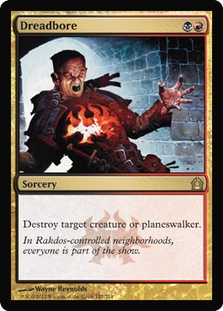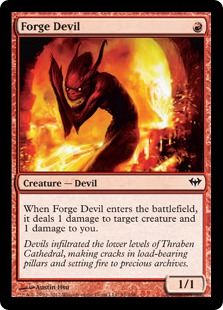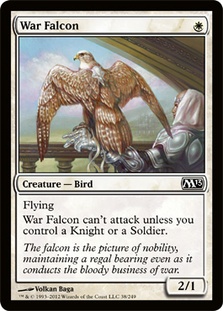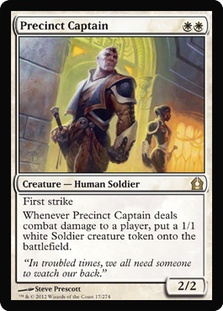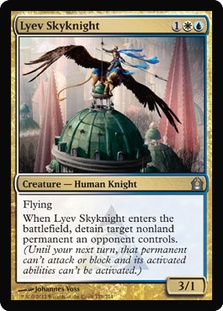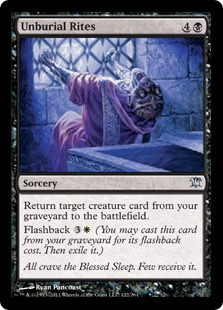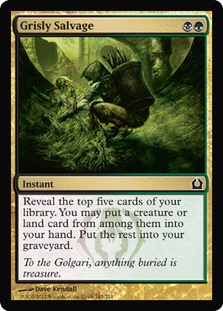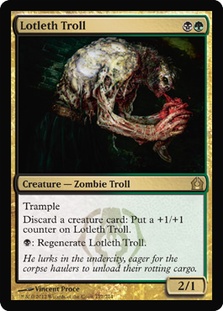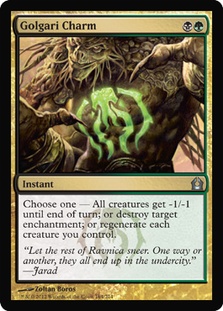SCG Open Series: Cincinnati took place this past weekend, setting the initial state of new Standard. The format looks interesting and diverse—Jund, Zombies, green decks, various White Weenie decks, and even control returned after a long hiatus. The gravy train made its first stop in Ohio, but will newcomers be able to catch it in Providence or Indianapolis? Obviously! New kids are waiting for their chance to change the line-up, using available tournament results as a benchmark.
Bump in the Night was the very first card to catch my attention during the live coverage of SCG Standard Open: Cincinnati. The card is the real deal. I played it in Modern, where both Lightning Bolt and Lava Spike are legal. Three damage costs two or even three mana in Standard, so Bump in the Night is interesting, and, from my Modern experience, flashing it back is possible in a 21-23 land deck, even if it’s not what we’re dreaming of. Joe Bernal opted for it in black-based Zombies (you can find his deck tech here), but I think it’s more promising in a red-based deck because it’s faster and relies on burn spells rather than creatures.
Mono Red suffers because of Thragtusk, but there are no cheaper anti-red cards (Centaur Healer is not heavily played), and the return of shocklands means that all ambitious three-colored decks will lose life or lose tempo, which is even worse for them. If it’s possible to build a Mono Red deck that is fast enough to win before Thragtusk hits the table or after the first copy, the deck will fight at the high tables.
Creatures (22)
- 4 Stromkirk Noble
- 4 Falkenrath Aristocrat
- 2 Guttersnipe
- 4 Rakdos Shred-Freak
- 4 Ash Zealot
- 4 Rakdos Cackler
Lands (12)
Spells (26)
- 10 Mountain
- 2 Brimstone Volley
- 4 Bump in the Night
- 4 Pillar of Flame
- 2 Flames of the Firebrand
- 4 Searing Spear
Sideboard

Dreadbore is necessary to beat big monsters and, more importantly, Jace, Architect of Thought and his new girlfriend, Tamiyo, the Moon Sage (sorry, Stoneforge Mystic, but it’s official now). Both blue walkers are going to have five loyalty counters after their first activation, so just burn isn’t enough, while Dreadbore is a universal answer that is useful against variety of troublesome decks. It’s the main reason to play R/B over pure Mono Red or U/R Burn.
Forge[/author] Devil”][author name="Forge"]Forge[/author] Devil, in contrast, is a way to deal with small creatures. Do you remember how good Gut Shot was in the format of Delver of Secrets and Birds of Paradise? Avacyn’s Pilgrim and Arbor Elf are very popular right now, and White Weenie contains many one-toughness creatures (Knight of Glory, War Falcon, Champion of the Parish, occasionally Lyev Skyknight, etc.). Forge[/author] Devil”][author name="Forge"]Forge[/author] Devil isn’t a two-power one-mana creature, but he is easily a card that can fight against green decks by suspending Thragtusk for a turn.
The downside of smaller power and damage to you is huge, but I guess that this trade would be favorable for the red deck. Other available options are Geistflame and Electrickery, but I’d rather have a body attached to cheap removal—and yes, my Mono Red lists don’t include Vexing Devil. The reason is simple. While Forge[/author] Devil”][author name="Forge"]Forge[/author] Devil is not always useful, you can wait for appropriate moment and maximize its value; Vexing Devil, in contrast, never does what you want, and if you’re able to give your opponent a lose-lose choice, you’re probably capable to win with any other nonland card from your deck anyway.
Another question: is Rix Maadi Guildmage worth playing? I’m excited to play this card in Limited, but, you know, nobody blocks in Constructed. However, there are very few ways to sneak through (probably green) big creatures, so they all should be considered as ways to add "kicker" to your burn spells. I think about Rix Maadi Guildmage as a cheaper and probably worse Olivia Voldaren. Its main advantage is a cheaper cost—that is pretty relevant in 22-land deck with the fourth slot already occupied by the superior Falkenrath Aristocrat.
Less clunky ways to deal some damage through a stalled battlefield are Hellrider and Guttersnipe. The former costs four mana and, even if not demanding more mana afterwards, isn’t going to oust Falkenrath Aristocrat from a R/B deck. The latter is an interesting addition to a deck with sixteen burn spells. The little Goblin is slower than other options, but if you untap with him, it’s easy to burn some souls.
However, maximizing the little Goblin’s value requires U/R over B/R and trading Bump in the Night and Falkenrath Aristocrat for Snapcaster Mage and Goblin Electromancer (and maybe some spells with flashback). Sadly, Ash Zealot isn’t very good with Snapcaster Mage, so Rakdos Shred-Freak takes her place (while if we didn’t actually have spells with flashback, Snappy and Zealot would coexist).
Creatures (23)
- 4 Snapcaster Mage
- 4 Goblin Electromancer
- 3 Guttersnipe
- 4 Rakdos Shred-Freak
- 4 Blistercoil Weird
- 4 Rakdos Cackler
Lands (8)
Spells (27)
- 8 Mountain
- 2 Island
- 4 Brimstone Volley
- 4 Pillar of Flame
- 3 Flames of the Firebrand
- 4 Searing Spear
- 2 Mizzium Mortars
Sideboard

This counter-burn deck is the best Izzet deck I can imagine. Caleb Durward played U/R Delver at the SCG Standard Open in Cincy, but I don’t see how his list can deal with early aggression without a flipped and alive Delver of Secrets, so I prefer to be as aggressive as possible and avoid Delver due to lack of topdeck manipulation. Delver of Secrets is a trap because it demands many noncreature spells while low-creature decks are unable to provide enough pressure.
I think that solutions for Delver must include either Gather the Townsfolk or Krenko’s Command, which simply aren’t good right now. Delver Humans might be viable, but I’d rather try a clean Humans deck, which has the perfect tools to beat the fearsome Zombies without weird compromises in the favor of the old tournament favorite.
Humans’ problem in the previous format was the lack of a second good one-mana creature to support Champion of the Parish; now we have the interesting War Falcon. It was often hard to provide enough support for the Falcon in M13 Sealed Deck, but almost all good white creatures are Knights or Soldiers, so the Falcon should be able to attack while its evasion is not to be underestimated.
Another important reason to play White Weenie is that both dedicated anti-Zombies creatures are good enough to be maindeck. Elite Inquisitor finally found his place in Standard, and all three of his abilities are surprisingly relevant (hello, Olivia Voldaren!). Aside from these two, Humans has a great selection of two-mana creatures, including Thalia, Guardian of Thraben, Mikaeus, the Lunarch, and the probably underestimated Precinct Captain.
Andrew Shrout placed in the Top 16 at the SCG Standard Open in Cincinnati with a very interesting U/W list with Feeling of Dread. This card makes Precinct Captain better than he was supposed to be. White Weenie has a ton of first strike creatures, so Feeling of Dread can easily make your opponent have to choose between taking enormous amounts of damage and unfavorable chump blocking. Lyev Skyknight is an interesting additional source of evasion for the deck. It’s obviously not as good as Sublime Archangel, but it’s cheaper and allows alpha strikes—which is good since we’re talking about White Weenie.
Lyev Skyknight and War Falcon prove a funny thing—the toughness of evasive creatures doesn’t really matter these days. There is no Gut Shot, while Tragic Slip and Olivia Voldaren are the only popular cards that can deal with one-toughness creature much easier than larger ones. Searing Spear, Dreadbore, Dead Weight, and others aren’t really concerned with toughness, so there’s no reason to care about toughness if we don’t expect blockers. This situation will immediately change if Lingering Souls sees enough play, but I don’t expect it.
Creatures (31)
- 3 Elite Inquisitor
- 2 Fiend Hunter
- 4 Champion of the Parish
- 4 Geist of Saint Traft
- 4 Silverblade Paladin
- 2 Sublime Archangel
- 4 Knight of Glory
- 4 War Falcon
- 4 Precinct Captain
Planeswalkers (3)
Lands (9)
Spells (17)
- 12 Plains
- 2 Island
- 3 Feeling of Dread

I’m not a fan of Riders of Gavony or Spectral Flight in this deck because the former is too slow and probably overkill against Zombies and the latter is too risky without additional hexproof threats. This situation could change if ramp-style Jund with Dreadbore and Mizzium Mortars prevails over aggressive Jund and Zombies, but the risk of Searing Spear or even Ultimate Price is too high right now.
The deck suffers from the rotation of Honor of the Pure, but it became even better nonetheless. White Weenie is overwhelmingly good against black decks, which could be key early during the format. However, the control matchup is very tough, but there are some tools that can solve that problem. The main purpose of the sideboard is to support heavy boarding against U/W/R Miracles.
Thalia, Guardian of Thraben and some Pithing Needles don’t totally solve the problem, but they are very useful and help improve the deplorable situation. The clear polarization of certain matchups was one of my most important observations from the SCG Open Standard Open in Cincinnati, so all decks require careful tuning to win, and there are definitely some opportunities for everyone to make bad matchups much more realistic.
White Weenie was one of the most underestimated decks of spoiler season, but not quite as much as Unburial Rites since Grisly Salvage is strictly superior to its predecessors. Three different versions of Reanimator took four places in the Top 64 of the SCG Standard Open in Cincinnati, and the graveyard hate level isn’t high these days, so there is a good chance that the deck will continue to perform well.
I’d prefer the deck with a strong backup plan to dedicated combo because there are some very good options for surviving the early turns until we’re ready to assemble our "combo" with Angel of Serenity or Angel of Glory’s Rise as primary Reanimation targets. The first one is more powerful on her own, but the second one is better in the proper deck and is a must-have against Zombies. A third possible version is Junk Midrange with Unburial Rites to rebuy valuable creatures.
Creatures (13)
Lands (23)
Spells (24)

This list is an example of dedicated combo, but it’s still viable to play without Unburial Rites postboard, as a complicated mana base allows reboarding into a sort of control deck with additional removal. By the way, the complicated mana base is the exact thing I dislike in this list. Its red cards are Faithless Looting (fairly necessary), Rolling Temblor (replaceable), Dreadbore (possibly replaceable), and sideboarded Bonfire of the Damned.
The lack of early board interaction followed by strong three-mana cards allows the deck to sculpt mana with minimal pain, but I think that I’d cut red from this deck in the favor of four Lotleth Troll (a great blocker and discard outlet), the fourth Centaur Healer, the second Golgari Charm, the fourth Lingering Souls, and Abrupt Decay. Angel of Glory’s Rise would come in the sideboard, even without of Humans anywhere in the 75.
As I said, I’d prefer a deck where Unburial Rites is not a combo plan but rather a way to prevail in the long game, threatening to win with powerful creatures and rebuying them after opposing removal. Plan B is to prefer creatures with ETB abilities and utilize Restoration Angel. So my deck would be the following:
Creatures (21)
- 4 Borderland Ranger
- 4 Restoration Angel
- 1 Sigarda, Host of Herons
- 4 Thragtusk
- 2 Angel of Serenity
- 4 Centaur Healer
- 2 Armada Wurm
Planeswalkers (2)
Lands (19)
Spells (18)

There is some shortage of early plays, but I’m not sure if Gatecreeper Vine is good enough. I decided to play Farseek to ensure an early appearance of threats, and Selesnya Charm is an emergency answer to an early rush. However, as soon as we stabilize, Thragtusk and Centaur Healer preserve our life total while nearly any creature requires an immediate answer—or answers, as soon as Unburial Rites and Restoration Angel are available. This list doesn’t look good against Miracles, but I’d be happy to play with it against nearly everything else, including the fresh decks which surely will emerge in upcoming weeks.
Do you remember how much time was spent on building Illusions in the early days of Innistrad Standard? Current Standard is far from equilibrium, many cards are waiting for their time, and I don’t see any reason to avoid brewing. These days are the most interesting time of the whole year, so just follow your imagination!

